Exploring the Significance and History of Ruby
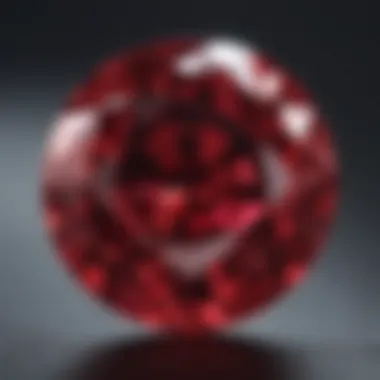
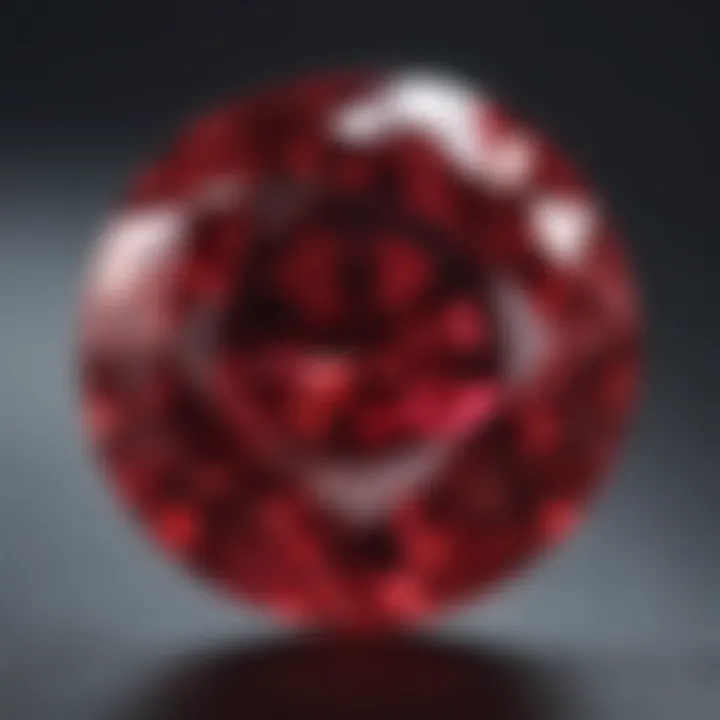
Intro
Rubies, known for their striking red hue, have captivated individuals for centuries. This gemstone not only serves as July's birthstone but also holds a unique place in various cultures across the globe. Bursting with symbolic significance, rubies have been associated with love, passion, and power. As we journey through this exploration, we will examine the geological origins, qualities, and historical contexts that make rubies much more than just beautiful gems.
Gemstone Overview
Definition and Origins
Rubies are a variety of the mineral corundum, specifically characterized by their red coloring. The red hue comes primarily from the presence of chromium. Their formation typically occurs over millions of years through high-pressure and high-temperature geological processes. Found in metamorphic rocks, rubies often share their habitat with sapphires, another prized member of the corundum family.
These exquisite stones are not just found anywhere; significant deposits can be traced back to regions like Myanmar, Thailand, and Mozambique. The allure of rubies goes beyond aesthetics; they embody a rich geological history.
Historical Significance
Throughout history, the ruby has held an esteemed position. In ancient times, Indian royalty adorned themselves with rubies, believing the gems provided protection and bestowed wealth. The ancient Greeks and Romans also revered rubies, linking them to the god of war, Mars, reflecting the stone’s fierce and vibrant nature.
Many legends surround the ruby. In one popular tale, it is said that Solomon, the wise king, wore a ruby ring that channeled its powers and brought him victory in battle. These accounts only scratch the surface of how deeply embedded rubies are in human culture.
"Rubies have long been symbols of majestic power and a coveted treasure across civilizations, shaping stories of love, bravery, and prosperity."
Gemstone Properties
Hardness and Durability
Rubies score a 9 on the Mohs scale of mineral hardness, making them the third hardest natural mineral. This impressive durability means that rubies can withstand daily wear, making them ideal for various types of jewelry. When cared for properly, they tend to retain their beauty even with age. However, one should still exercise caution, as excessive force can lead to chipping or scratching.
Color and Clarity
The brilliance of a ruby primarily lies in its color. The ideal shade is considered to be a deep, vivid red, often referred to as "blood-red." Factors such as lighting can influence how the color is perceived, so it's essential to view rubies in different lighting conditions for a true assessment.
Clarity is another key attribute; while many rubies contain inclusions, the impact on beauty varies. High-quality rubies may show minimal inclusions visible only under magnification, while lower quality stones might have noticeable flaws. Collectors often prefer stones with rich color and high clarity, which contributes to their value in the market.
In summary, understanding the key properties of rubies lays a strong foundation for appreciating these remarkable gemstones. Their historical significance and robust qualities combined make them not only a beautiful adornment but also an investment of significant worth.
Understanding Birthstones
Birthstones hold a unique position in the world of gemstones, interwoven with tradition, belief, and personalization. Each month of the year is assigned a specific stone, thought to bring good luck, protection, or other significant benefits to individuals born during that time. This attribute makes birthstones more than just decorative gems; they serve as symbols of identity and cultural heritage.
Understanding birthstones is crucial for anyone interested in gemstones, as they provide a deeper connection to these stones beyond aesthetics. They are often chosen for personal jewelry pieces, making them a thoughtful gift for birthdays or anniversaries. Besides their sentimental value, birthstones often embody celebrated meanings and historical stories, enriching their allure.
Definition of Birthstones
Birthstones are typically precious or semi-precious stones associated with each month of the year. These stones are thought to symbolize qualities important to people born in that month. For instance, individuals born in July proudly claim the ruby as their birthstone. When we think of rubies, what often crosses the mind is their vibrant red color, but their significance also extends to love, passion, and vitality.
The origins of these associations can be traced back to various traditions around the world, including the ancient Hebrew and Hindu lists of gemstones. So, these stones often represent multifaceted meanings, reflecting various cultures and beliefs.
Historical Overview
The history of birthstones is quite rich and varied. Documented tales date back to ancient civilizations. The Babylonians are often credited with creating the first known list of gemstones in the 1st century AD, which assigned specific stones to each month. Over centuries, these associations evolved, integrating lore from different cultures.
For example, during the Middle Ages, this practice became intertwined with the belief in the spiritual power of stones. Many believed that wearing a birthstone would protect the wearer and bring them good fortune. As a result, various cultures began shaping their myths and stories surrounding these gems, making them hallmark pieces treasured throughout generations.
Cultural Relevance
Birthstones resonate differently across cultures. In Western societies, the tradition has largely remained intact. However, in Eastern cultures, like in Hindu traditions, different stones hold different meanings, and they emphasize planetary gemstones that vary significantly from Western traditions. For instance, while the ruby represents July in the West, in Hindu culture, it is often associated with the planet Sun.
In addition to the cultural variations, the practice of gifting and wearing birthstones transcends mere ornamentation. It acts as a link, binding countless individuals across continents, reinforcing community through shared beliefs about luck, health, and protection.
Understanding birthstones encourages individuals to connect with their heritage and to appreciate not only the beauty of these gems but also the stories and meanings they carry through history. This depth adds to the charm of gemstones, making every wear or gift more special.
The Ruby: July's Birthstone
Rubies are not just gemstones; they carry with them a history and a legacy that has attracted attention through centuries. As the birthstone of July, the ruby stands tall among precious stones due to its striking color, rarity, and cultural significance. Understanding what makes the ruby essential goes beyond its physical allure; it brings in an interplay of geological elements, historical connotations, and emotional resonances that make it a prized possession. In this section, we will delve into the geological formation of rubies, their physical properties, and the intricate details of their chemical makeup, unraveling the essence of this magnificent gem.
Geological Formation
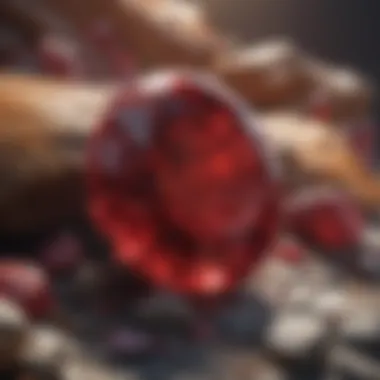
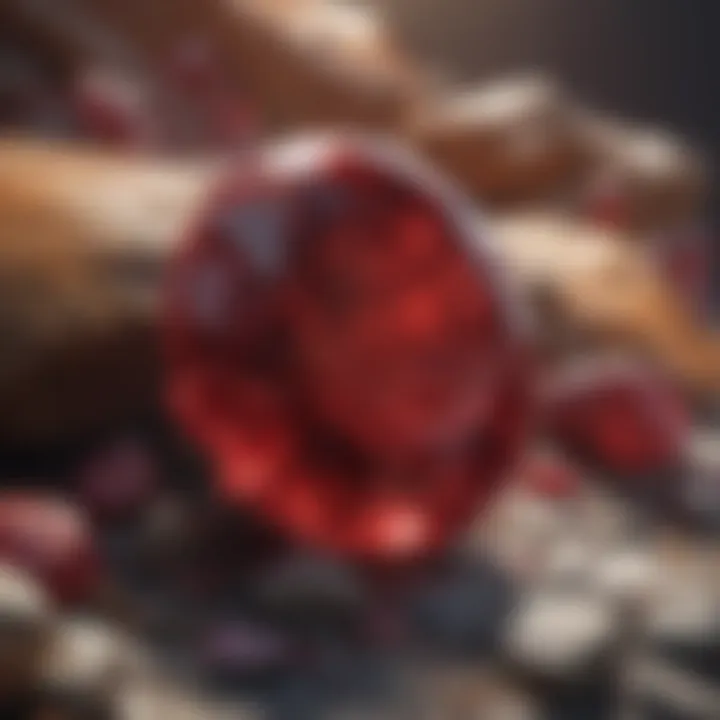
Rubies originate from the mineral corundum, a form of aluminum oxide which only acquires its vibrant red hue when chromium is added during its formation. This fascinating transformation usually occurs deep within the Earth’s crust, where intense heat and pressure enable the crystals to form. The geological journey of rubies often spans millions of years, where they are subjected to various environmental factors.
The presence of rubies is most often associated with metamorphic rocks, especially in regions known for alpine terrains. For instance, one of the most renowned sources of rubies is Myanmar, with its high-quality stones that have captivated collectors and aficionados alike. Rubies also find their place in other parts of the globe, such as Sri Lanka and Thailand, which have their unique geological settings contributing to distinctive characteristics in their rubies.
Physical Properties
The physical properties of rubies are a tapestry of their beauty that highlights why they command such high regard in jewelry and investments. Let’s explore this facet more deeply.
Color Variations
Color is arguably the most prominent feature of rubies. Despite commonly being associated with a deep red shade, rubies can exhibit color variations ranging from pinkish-red to purplish-red. This variation arises from the quantity of chromium present during formation, influencing the overall hue.
It's noteworthy to mention that the intensity of the color plays a crucial role in determining the value of the ruby. A vivid, blood-red ruby typically holds greater desirability compared to lighter shades.
However, buyers should approach with caution as some variations can resemble less valuable stones like pink sapphires. This overlapping quality can sometimes mislead potential owners if not properly verified.
Hardness and Durability
When it comes to durability, rubies shine brightly. They score a formidable 9 on the Mohs scale, making them one of the hardest gemstones available. This hardness means that rubies can withstand everyday wear and tear, making them a sensible choice for rings and other frequently worn jewelry items.
Their resilience ensures that they require less maintenance compared to softer stones, thus providing longevity. Nonetheless, it's wise to handle them with care, as although they are hard, sudden impacts can still cause them to chip.
Clarity and Cut
Clarity, although less celebrated than color, carries notable weight in assessing a ruby's value. High-quality rubies exhibit few inclusions, commonly known as "silk," which can enhance their optical properties by dispersing light in intriguing ways. When it comes to the cut of a ruby, each facet plays an integral role in showcasing its brilliance.
A well-cut ruby that reflects light optimally can appear more lively and vibrant. Outputs from various cuts, such as oval or cushion, contribute uniquely to its sparkle and is often a matter of personal preference among buyers, thereby impacting their overall allure.
Chemical Composition
The chemical composition of rubies clarifies their identity among other gemstones. Mainly composed of aluminum oxide, the inclusion of chromium gives rise to that characteristic red tone, distinguishing rubies from sapphires, which are also a form of corundum.
Other trace elements can also impact their hue; iron may result in more purple tones, while traces of titanium can lead to deeper reds. The complex interplay of these components allows gemologists to evaluate and categorize rubies, paving the way for informed choices for collectors and enthusiasts alike.
"Every ruby tells a story of its origins, forming a diverse mosaic of colors and textures which echo the Earth’s ancient past."
With these foundational elements explored, it’s clear that the ruby is not merely a vibrant adornment but a gemstone steeped in a fascinating world of geological marvels and cultural meanings.
Historical Significance of Rubies
The role of rubies in history is as rich and vibrant as the gemstone itself. Known for its striking colors and rarity, the ruby has held a prominent place in many cultures around the world. Understanding the historical significance of rubies not only brings forth curiosity but also an appreciation for their role in shaping civilizations.
Ancient Civilizations
In ancient times, rubies were considered the most valuable gemstones. They were often associated with power, passion, and protection. Take, for instance, the ancient Hindus who referred to rubies as “the king of gemstones.” They believed that wearing a ruby could grant one health, wealth, and even eternal life. This perspective was not confined to just one region; the ancient Romans also prized rubies, regarding them as a symbol of invincibility and courage. In battle, soldiers would wear rubies as a talisman to protect them from harm. By burying rubies with their dead, ancient cultures sought to ensure not only safe passage to the afterlife, but also the continuance of influence and wealth in another realm.
- Key Points:
- Rubies were seen as symbols of power and protection.
- Potential beliefs included health benefits and immortality.
- Ancient civilizations often linked rubies to battle valor and safe passage into the afterlife.
Medieval Lore
Jumping forward a few centuries, rubies continued to fascinate humanity. In medieval Europe, rubies held such significance that they were often associated with royalty. Kings and queens wore them, believing they possessed protective qualities from ailments, misfortune, and even evil spirits. The passionate red of rubies was thought to symbolize blood and life, making them ideal for crowns and other royal insignia. Additionally, folklore depicted rubies as gemstones that could change color, alerting the wearer to danger. This blend of reality and myth surrounding the ruby solidified its status not just as a jewel, but as an object of desire and intrigue.
“The passion of life is the song of the ruby.”
- Highlights:
- Rubies were believed to possess protective qualities during medieval times.
- The color red symbolized life, making rubies highly desirable among royals.
- Legends associated with color change increased the mystique of rubies.
Modern Adaptations
Fast-forwarding to the contemporary era, rubies have not lost their charm. In fact, their significance has evolved into a mix of aesthetics and investment. Nowadays, rubies are not only prevalent in traditional jewelry but also feature prominently in modern design, often paired creatively with other gemstones. Collectors show heightened interest in rubies, particularly unheated varieties, which are rarer and command higher prices. The challenge lies in the proper grading and understanding market trends to appreciate their value fully. Moreover, ethical sourcing and transparency are becoming increasingly vital as consumers grow more conscious of the origins of these stunning stones.
- Observations on modern usage:
- Rubies are gaining a reputation for investment potential.
- Contemporary jewelers are experimenting with innovative designs.
- Ethical considerations in sourcing are becoming increasingly important for consumers.
In summary, the historical significance of rubies spans across cultures and eras, showcasing them as more than just beautiful stones. As rubies transition further into modern society, their rich heritage continues to inspire admiration and awe from gemstone enthusiasts and collectors alike.
Symbolism and Meaning
The ruby, as the birthstone for July, carries profound significance beyond its physical beauty. It is wrapped in layers of symbolism that reflect human emotions, aspirations, and cultural narratives. People often find themselves drawn to rubies not merely for their dazzling appearance, but for the positive energies and meanings that this stone embodies.
In various cultures, rubies symbolize love, passion, and devotion. This depth of meaning makes them fitting for engagements and anniversaries, where commitment is celebrated. They are not just gems to adorn; they encapsulate essential values and emotions that resonate across generations.
Cultural Interpretations
East vs. West
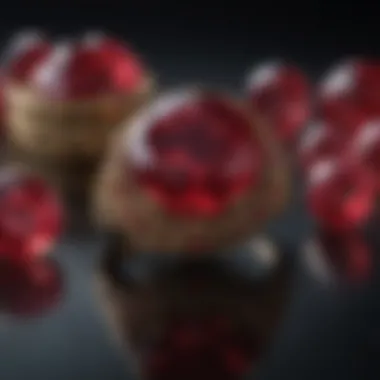
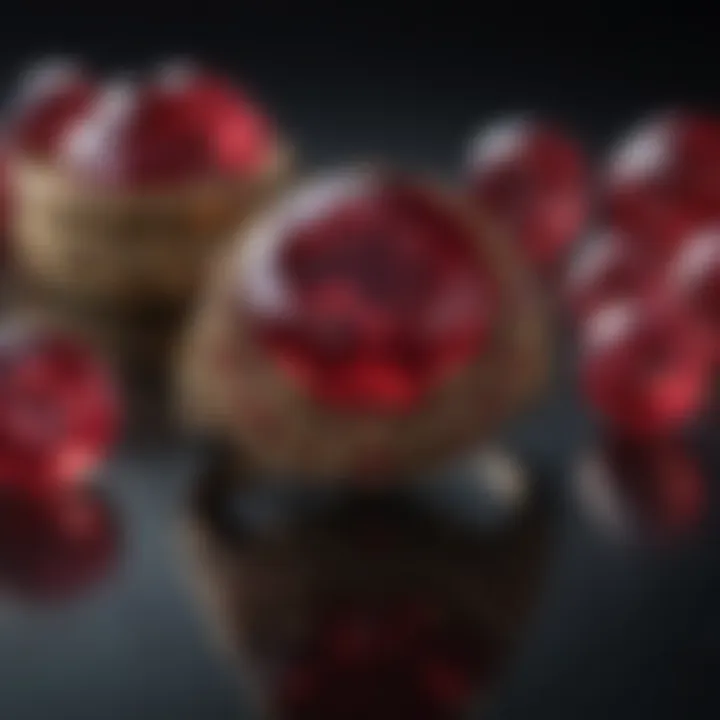
In the Eastern world, particularly in places like India and Southeast Asia, rubies are viewed as symbols of power and prosperity. Many believe that wearing a ruby can attract wealth and success. They are often used in traditional forms of jewelry, such as in bridal sets, highlighting their importance in cultural celebrations. The vibrant red hue of rubies is seen as a reminder of life and vitality, making them a popular choice for family heirlooms passed down through the generations.
On the other hand, in the Western cultures, rubies are often associated with romance and passion. They are frequently chosen for engagement rings due to their deep red color, which signifies deep love and commitment. The distinct preference for rubies in Western attitudes stems from their historical association with nobility and the royal lineage. The contrast between the two perspectives enriches the overall appreciation for rubies within this article, showcasing their versatility and multifaceted charm.
Religious Significance
The religious interpretations of rubies add another layer of richness to their symbolism. In Christianity, rubies are often associated with the blood of Christ and are seen as symbols of sacrifice. In Buddhist traditions, rubies represent purification and are said to bring peace and happiness.
These spiritual associations elevate the ruby's presence in various religious celebrations and practices. The unique feature of ruby's spiritual significance is that it tends to unify people across cultural and religious lines. In the context of this article, recognizing such meanings deepens our understanding of why rubies are more than just precious stones; they represent core values that resonate with individuals from all walks of life.
Metaphysical Properties
Emotional Healing
Many believe that rubies have the ability to promote emotional healing. The lush red color is thought to resonate with the heart chakra, aiding in emotional balance and nurturing self-love. This makes rubies a popular choice for those seeking to overcome feelings of fear or insecurity. People who embrace the emotional healing properties of rubies often talk about their experiences of increased feelings of warmth and compassionate love in their lives. This aspect makes rubies not just aesthetically pleasing but also appealing from a holistic perspective.
Spiritual Growth
The ruby is also known as a stone of spiritual growth. It is thought to stimulate the heart and align one’s energies with the spiritual realm. For those on a path of enlightenment, the ruby can bolster courage and confidence while facing life's challenges. This appealing aspect of the ruby encourages individuals to embrace their spiritual journey, making it a valuable companion for seekers.
Its unique properties of fostering resilience and courage empower people to delve deeper into their personal growth, enhancing the overall narrative of the ruby's importance throughout this article.
In summary, rubies embody a rich tapestry of meanings that speak to human emotions, culture, and spirituality. Their varied symbolism reflects not just their beauty, but the complex interplay of values and beliefs that make them cherished across time and regions.
This exploration of the symbolism and meaning of rubies serves to elevate the appreciation of this birthstone, showing its relevance to both personal expression and broader cultural contexts.
Rubies in Jewelry
Rubies have captivated humanity for centuries, earning their spot as one of the most sought-after gemstones in the world. Their rich red hue, often associated with passion and power, makes them a staple in the jewelry industry. When discussing rubies in the context of jewelry, it’s essential to explore the different types, their value, and the proper care they require. This section sheds light on each aspect, offering insights into why rubies are a favored choice for many.
Types of Ruby Jewelry
Rings
Rings featuring rubies are more than just adornments; they often symbolize commitment or a personal milestone. Whether set in gold, silver, or platinum, ruby rings offer a striking contrast that catches the eye. The deep red of a ruby stands for love and is often chosen for engagement or anniversary rings.
One notable aspect of ruby rings is their versatility. From simple solitaire designs to intricate vintage styles, there's something for everyone. A unique feature of these rings is the option to combine rubies with other gemstones, like diamonds or sapphires, offering a colorful twist to the classic look. The only downside might be the price, as quality rubies can be quite costly, but many consider the investment worthwhile.
Earrings
Ruby earrings bring a touch of elegance to any outfit. They are often favored for formal occasions or as part of a lavish evening ensemble. Many choose these earrings not just for their beauty but for the way they can highlight one’s features.
The key characteristic of ruby earrings lies in their ability to be both statement pieces and subtle enhancements. Studs can be understated while hoops and dangling earrings can make a bold statement. However, one consideration is that they require careful handling; the unique cuts may be prone to snagging or being damaged with rough use, meaning less frequent wear may preserve their beauty.
Necklaces
When it comes to necklaces, rubies can range from simple pendants to elaborate statement pieces. A ruby pendant on a delicate chain offers a sweet, romantic touch, perfect for everyday wear or special occasions. On the other hand, a grand ruby necklace can serve as a showstopper.
The standout aspect of ruby necklaces is their presence. A well-crafted necklace can seamlessly draw attention without being overbearing. Nevertheless, much like earrings, the size and associated price can fluctuate widely. Large rubies command higher prices and may not be attainable for everyone, restricting some from owning such splendid pieces.
Value and Rarity
The value of rubies is influenced by color, size, and quality. The deeper and richer the red, known as "pigeon's blood", typically results in a higher price. These gemstones are also rarer than diamonds, contributing to their esteemed value in the market. With high demand and constrained supply, investing in rubies can prove financially wise, but potential buyers should do their homework to understand the nuances of gem grading.
Caring for Ruby Jewelry
Cleaning Techniques
Maintaining the luster of ruby jewelry requires a few simple cleaning techniques. A soft cloth can work wonders, but for deeper cleans, mild soap mixed with warm water is ideal. Rubbing alcohol can also be used, though caution is needed to avoid any rough scrubbing that could scratch the gem. Regular cleaning keeps the gemstone shining, allowing its vibrant color to continue to enchant.
Storage Recommendations
When not being worn, rubies should be stored safely. Keeping them in a cloth pouch or a dedicated jewelry box lined with soft fabric can minimize scratches and potential damage. It’s also wise to separate them from other jewelry pieces to avoid any unpleasant surprises, like scratches from harder stones. Taking these precautions makes a significant difference in maintaining their brilliance over time.
Investment Potential
When it comes to investing in gemstones, the ruby stands tall among its peers. Its striking color, rarity, and cultural significance create a unique value proposition for collectors and investors alike. While many might turn to traditional assets, investing in rubies offers an intriguing alternative that blends beauty with financial promise.
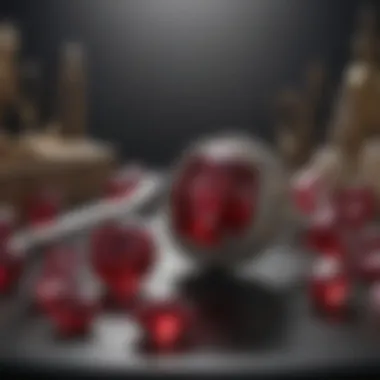
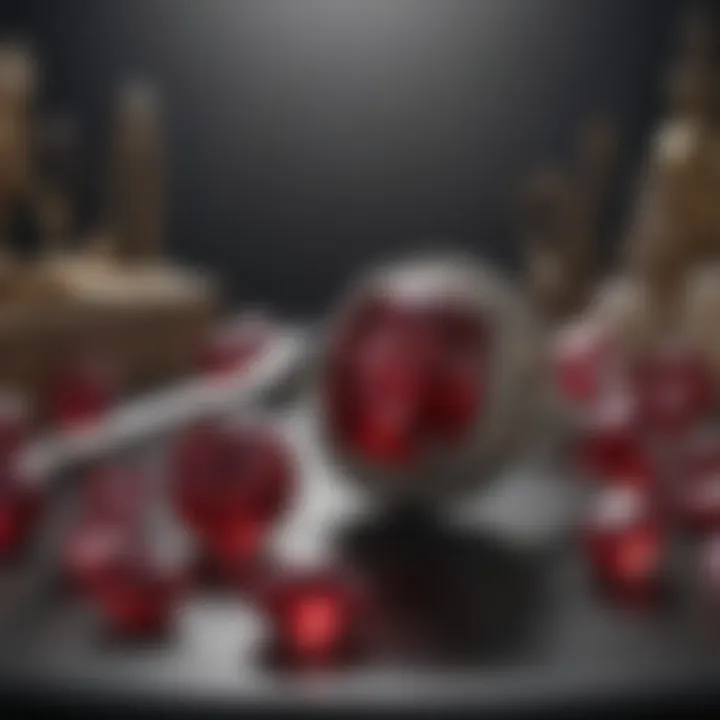
Market Trends
In recent years, the ruby market has seen significant fluctuations and trends worth noting. High-quality rubies, particularly those from Myanmar, have surged in popularity due to their exceptional color saturation and clarity. Prices can soar based on auction results, signaling a robust demand among wealthy collectors. According to recent reports, some exceptional rubies have been known to fetch prices in the multi-million dollar range.
"Investment in gemstones is not just about aesthetic allure; it's also a calculated risk based on market insights and trends."
Moreover, the growing interest in colored gemstones is reshaping the market. While diamonds have been the front-runners in the jewelry industry, rubies are catching up as more consumers seek unique and rare pieces. This trend has led to a rise in interest for investment-grade stones, steering collectors to explore acquiring rubies as a hedge against inflation and financial instability.
Condition and Grading
Understanding the condition and grading of rubies is integral to assessing their investment potential. The Gemological Institute of America (GIA) provides a grading system that evaluates color, clarity, cut, and carat weight, commonly referred to as the "Four Cs". When it comes to rubies:
- Color: The most vital factor in grading. Vivid red hues, often referred to as "pigeon's blood," are considered the most valuable.
- Clarity: While some inclusions might be acceptable, stones with fewer inclusions and greater transparency typically command higher prices.
- Cut: A well-cut ruby will have significant brilliance and fire, enhancing its overall appeal.
- Carat Weight: Larger rubies are scarce, making them more sought after. A two-carat ruby can be worth considerably more than a smaller stone of similar quality.
Being well-versed in these criteria allows investors to discern the true worth of rubies in their collection. Collectors should also consider obtaining a certificate from reputable grading organizations, as this adds legitimacy when reselling.
Long-Term Value
Investing in rubies is more than just a fleeting trend; it often serves as a long-term investment strategy. Historically, gemstones have maintained or increased their value over time, providing a safety net during economic downturns. Unlike stocks or bonds, real assets like rubies have an intrinsic value that do not easily fluctuate with market sentiments.
The allure of owning a tangible asset like a ruby can also play a psychological role in its investment perception. Rare rubies, especially those with unique characteristics, tend to hold their value better, making them a strong consideration for long-term portfolios.
As the global appetite for luxury goods increases, so too does the potential for rubies to appreciate in value. It is essential for investors to keep an eye on changing consumer preferences and market demand, ensuring that their investments remain in sync with broader trends within the gemstone industry.
In summary, the investment potential of rubies is considerable, marked by vibrant market trends, precise grading standards, and promising long-term value. Investing in rubies isn't simply about the stone itself; it's about the passion and stories woven into its rich tapestry of history and allure.
Famous Rubies
The world of rubies is not just defined by their geological formation or metaphysical properties, but also significantly shaped by their storied history and the infamous pieces that have captured the hearts of gemstone enthusiasts. These spectacular stones often serve as symbols of wealth, power, and allure. Understanding famous rubies offers insights into how these gems have transcended their physical magnificence and become legends in their own right.
Legendary Pieces
When diving into the exquisite realm of legendary rubies, a few names invariably surface. One cannot ignore the Imperial Ruby, said to have belonged to the last Emperor of Burma, King Thibaw Min. This impressive stone weighs around 100 carats and is celebrated not only for its size but also for its rich, deep red hue contextually tied to royalty. It famously adorned the crown jewels.
Another notable mention is the The Red Emperor Ruby, an awe-inspiring stone that once dazzled the public at Kunming Gem and Mineral Show before it was valued at over $8 million. Its deep color and remarkable clarity make it a preferred centerpiece for serious collectors. Much like these two, various rubies have roots steeped in historical significance, often surfacing during pivotal moments across different cultures.
Which rubies have drawn collectors' eyes and hearts through the ages? Here’s a brief list:
- The Hope Ruby: Part of the prestigious Hope Diamond collection, also known for its enchanting lore.
- The Black Prince's Ruby: A large red gemstone set in the Imperial State Crown of England, dating back to the fourteenth century.
- The Tiffany Ruby: An extraordinary 8.24-carats ruby from Tiffany & Co exhibited in prominent locations.
These legendary pieces are not merely stones; they each possess anecdotes and narratives that are steeped in history, often representing cultural symbols and societal values of their times. Their allure is as much about the stones themselves as it is about the legends and tales woven around them.
Notable Owners
Every gem has a history, but the notable owners behind these pieces magnify their significance and desirability. Take, for instance, Queen Elizabeth II, who has worn the Black Prince’s Ruby, reinforcing the bond between gems and royal lineage. Similarly, the Tiffany Ruby found an illustrious home with Tiffany & Co., bringing with it a legacy steeped in luxury and style.
Let’s also consider the spotlight on Maharani Sita Devi, a renowned figure who was not merely an aristocrat but also a true connoisseur of jewels. The rubies she owned were nothing less than show-stoppers, often inspiring envy among collectors and jewelers alike.
Whether it’s about its wearer or the backdrop of legendary rubies, these stones signify more than just valuable materials; they represent a tapestry of culture, tradition, and aspiration. The stories surrounding them elicit emotions that connect enthusiasts not only to the gem itself but also to the legacy and prestige that comes with owning such artifacts.
"A ruby is not only a precious gem, it reflects your history, your adventures, and sometimes, your dreams. Every scratch, every facet tells a story."
Thus, the narrative of rubies is enriched not just by their beauty but by the people who cherished and shaped their journey through time.
Ending
The journey through the intricate world of rubies, particularly for those born in July, reveals far more than just the striking beauty of this gemstone. It's a tapestry woven with threads of history, culture, and emotional significance, making it a pivotal topic for gemstone enthusiasts, collectors, and jewelry designers alike.
Recap of Ruby's Value
At its core, the ruby is a symbol of passion and vitality. Its rich crimson glow has enchanted civilizations for millennia, signifying not only love but also power and protection. Modern evaluations consider factors like color saturation, clarity, cut, and carat weight when assessing a ruby's monetary worth. Collectors particularly prize untreated stones that showcase a fine balance of these attributes.
Here are some key points outlining ruby's value:
- Color: The richest shades of red, known as "pigeon’s blood," command the highest prices.
- Clarity: The fewer inclusions, the more valuable the stone; however, some inclusions can add character.
- Cut: The craftsmanship behind the stone's cut can dramatically influence how light interacts with the ruby, enhancing its allure.
- Rarity: High-quality rubies are becoming increasingly scarce, further driving their market value.
The appreciation of rubies extends beyond their financial aspect. They are tokens of love and affection, often gifted during significant life events, which adds an emotional layer to their worth. As a birthstone, rubies also resonate deeply with personal identity, reflecting strengths such as courage and integrity.
Final Thoughts on Birthstones
In pondering the significance of birthstones, one realizes they are more than mere adornments. They embody cultural narratives and emotional connections. Birthstones, like the ruby, connect to historical beliefs, often thought to govern the wearer's fortunes and well-being.
Choosing a birthstone can be deeply personal. It might reflect individual traits or aspirations, representing a bridge between one’s identity and the cosmos. In today’s world, where mass production reigns, gifting or wearing a birthstone symbolizes a return to the meaningful, a way to anchor oneself amidst chaos.



